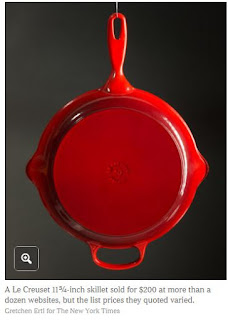When I was much younger, I remember watching "The Price is Right" with my grandmother. Many of the games involved trying to guess the "actual retail price" for various consumer items. Sometimes, it would be expensive items like cars. Often, it involved various random packaged goods from the grocery store like floor cleaner or dishwasher detergent.
Today, we've entered a new age. It seems everyone is looking for a deal. Major retailers like Macy's actually tried a strategy to wean their customers off of discount coupons only to hit fierce resistance from their most loyal customers. It seems that nobody likes to pay the same price as everyone else (even if it is a lower price than the "sale"!).
This article from the NY Times notices the trend. With the transparency of web shopping, they found the same sale price at numerous web sites with various percentages off the "list price". Which, of course, makes you wonder what the real "list price" was all along. It seems that no one pays list price. If that is the case, why would you even need it?
Here is one recent example of how retailers use list prices to motivate online buyers: Le Creuset’s iron-handle skillet, 11 ¾ inches wide and cherry in color.
Amazon said late last week that it would knock $60 off the $260 list price to sell the skillet for $200. Sounds like a bargain, the sort of deal that has helped propel Amazon to over $100 billion in annual revenue.
Check around, though. The suggested price for the skillet at Williams-Sonoma.com is $285, but customers can buy it for $200. At AllModern.com, the list price is $250 but its sale price is $200. At CutleryandMore.com, the list price is $285 and the sale price is $200.
An additional 15 or so online retailers — some hosted by Amazon, others on Google Shopping — charge $200. On Le Creuset’s own site, it sells the pan for $200.
This tactic is coming under increasing scrutiny:
“Offline retailers need blowout sales to draw traffic due to the costs of visiting a store — driving, then parking, walking and searching,” said Rafi Mohammed, a consultant and author of “The 1% Windfall: How Successful Companies Use Price to Profit and Grow.” “Online retailers don’t use blowout sales since it’s so easy to shop there. But to provide confidence to consumers that they are consistently getting good deals, it’s even more important for them to provide price comparisons.”
After the Overstock suit, online pricing policies are coming under greater scrutiny.
Two customers sued Amazon in late 2014, saying its list prices violated false advertising laws by bearing no relation to the prevailing market prices. The case was dismissed after Amazon pointed out that its customers gave up their right to sue in favor of binding arbitration.
Here is the link to the full article: http://www.nytimes.com/2016/03/06/technology/its-discounted-but-is-it-a-deal-how-list-prices-lost-their-meaning.html?ref…

No comments:
Post a Comment